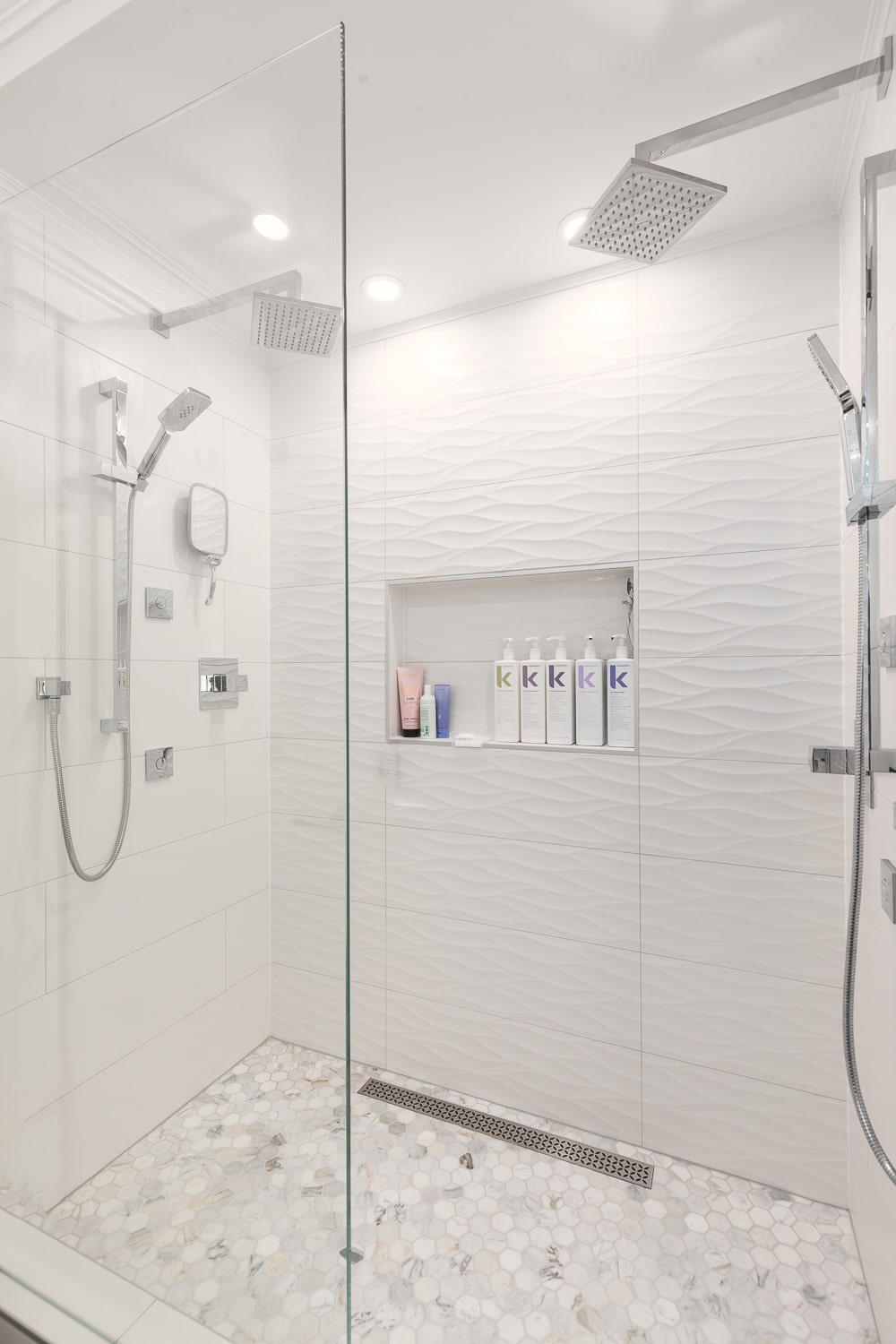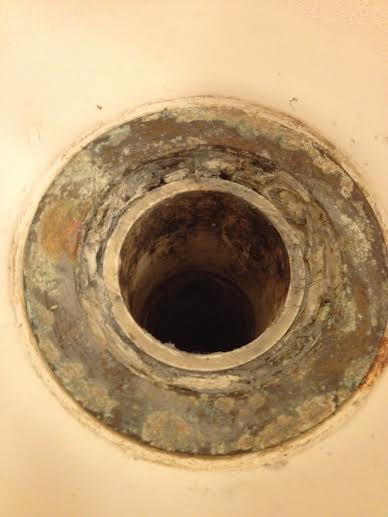
Your shower pipe may be dripping, but you don’t have to replace it if you’re looking for a quick and simple solution. Identifying the source of the leak and repairing it can save you money and time in the long run. It may take some time and research, but it’s possible to stop the leak temporarily with some pipe patching. Here’s what to do when you encounter a leaky shower pipe in your bathroom:
Understanding Shower Pipe Leaks: Causes and Prevention
Leaking shower pipes can be quite bothersome, but understanding the causes of these leaks is the first step in preventing them. Most leaks occur due to wear and tear, improper installation, or fluctuations in water pressure. Regular maintenance, such as checking for corrosion or loose fittings, can help prevent these issues from arising. It’s important to realize that a dripping shower pipe may not just be a minor annoyance, but rather a sign of larger plumbing problems. By addressing these issues early on, you can save both time and money in the long term.
Leaky shower pipes are a common problem that many homeowners face. These leaks can be caused by a variety of factors, including age, poor installation, or changes in water pressure. Regularly inspecting your shower pipes for signs of wear and tear, such as corrosion or loose fittings, can help prevent leaks from occurring. It’s crucial to understand that even a small drip can indicate a larger underlying issue with your plumbing system. By taking action early on, you can avoid more extensive and costly repairs down the line.
Preventing leaks in your shower pipes requires regular maintenance and vigilance. Checking for signs of corrosion, loose fittings, or other wear and tear is essential in identifying potential issues before they become major problems. Additionally, monitoring water pressure and addressing any fluctuations can help prevent leaks from occurring. It’s important to remember that a leaking shower pipe is not just an inconvenience, but a symptom of larger plumbing issues. By addressing these problems promptly, you can save yourself time, money, and the hassle of dealing with more extensive repairs.
Understanding the causes of leaking shower pipes is crucial in preventing future issues. These leaks can be caused by a variety of factors, including wear and tear from daily use, improper installation, or changes in water pressure. Regularly inspecting your shower pipes for signs of corrosion, loose fittings, or other damage can help identify potential leaks before they become major problems. It’s important to address any dripping or leaking pipes as soon as possible, as they can lead to more extensive damage if left untreated. By taking proactive measures, such as regular maintenance and prompt repairs, you can avoid the inconvenience and expense of dealing with a leaking shower pipe.
Leaky shower pipes can be a nuisance, but understanding their causes is essential in preventing them. These leaks can result from various factors, including normal wear and tear, improper installation, or fluctuations in water pressure. Regular maintenance, such as checking for corrosion or loose fittings, can help prevent these issues from occurring. It’s important to recognize that a dripping shower pipe may indicate larger plumbing problems that need to be addressed. By taking action early on, you can save yourself time, money, and the inconvenience of dealing with a more significant plumbing issue.
Preventing leaks in your shower pipes requires regular maintenance and attention. Checking for signs of wear and tear, such as corrosion or loose fittings, is crucial in identifying potential issues before they become major leaks. Additionally, monitoring water pressure and addressing any fluctuations can help prevent leaks from occurring. It’s important to understand that a leaking shower pipe is not just a minor annoyance, but a symptom of larger plumbing problems. By addressing these issues promptly, you can avoid more extensive damage and costly repairs in the future. Plumbing Maintenance Tips – HomeAdvisor
Step-by-Step Guide to Fixing a Dripping Shower Pipe
If you’re facing a dripping shower pipe, a step-by-step approach can be invaluable. Firstly, shut off the water supply to prevent further leakage. Next, identify the source of the leak – this could be from the showerhead, faucet, or behind the wall. Depending on the leak’s location, the repair process will vary. For instance, a leaky showerhead might require replacing a washer, while a deeper issue might need professional intervention. Ensure you have the right tools and replacement parts before starting the repair.
If the leak is from the showerhead, the next step would be to unscrew it from the pipe and inspect it for any visible damage. Occasionally, the problem could be as simple as a worn-out rubber washer. In such a case, remove the old washer, taking care to note its size and thickness. You can then visit a local store or search online for the appropriate replacement.
When purchasing a new washer, ensure it matches the exact specifications as the old one to ensure a perfect fit. Once you have the new washer, replace it in the showerhead and reattach the showerhead to the pipe. Turn on the water supply to check if the leak has been fixed.
If the leak is from the faucet, remove the handle of the faucet by unscrewing the screw located at the top. A ball, cartridge or a ceramic disk that’s worn out could be causing the drip. Make sure to replace it with an identical piece from a nearby store or an online retailer.
Bear in mind that if the leak is behind the wall, it may be a sign of a more serious issue such as a broken pipe or deteriorated plumbing. Repairing this would require professional expertise, as it involves breaking into the wall to reach the broken part of the pipe. A licensed plumber can assess the situation accurately, replace the necessary parts, and ensure the remainder of the plumbing is in good condition to prevent future leaks.
Performing these repairs can help you solve the issue of a leaking shower pipe. However, if even after performing these steps the leak continues, or if you are uncomfortable performing these repairs yourself, don’t hesitate to contact a professional plumber. It’s always best to address plumbing issues immediately, as prolonged leaks can cause substantial damage to your home, resulting in costly repairs. DIY Plumbing Repair – This Old House
Choosing the Right Materials for Your Shower Plumbing
Selecting suitable materials for shower plumbing is crucial for long-term durability and leak prevention. Options range from copper and PVC to PEX piping, each with unique benefits. Copper is durable and resists corrosion, but it’s more expensive. PVC is budget-friendly and easy to install but may not be as long-lasting. PEX is flexible and resistant to freezing temperatures, making it an increasingly popular choice. Consider factors like water quality, temperature, and usage frequency when choosing materials for your shower plumbing.
Understanding each material’s performance will help you optimize your shower system’s quality and lifespan. Let’s delve deeper into each type of material and its inherent features that might influence your decision.
Copper, though costly, has been the traditional choice for plumbing due to its sturdy nature and resistance to rusting. Its natural antibacterial properties add an extra layer of safety by preventing growth of bacteria in your water supply. However, installation of copper piping requires skilled labor, which might add to the overall cost.
PVC, known for its cost-effective properties, is a handy choice for those on a budget. Its lightweight nature makes it easy to handle and install, minimizing the chances of labor-induced issues and mistakes. The downside is it’s not as durable and may succitably to high-hot water temperature over time, making it a less favorite choice for hot water plumbing.
On the other hand, PEX (Polyethylene cross-linked) is a flexible, high-density plastic material that is becoming very popular in the plumbing industry. The material can withstand freezing temperatures, reducing the risk of rupture and leaks associated with freezing pipes. Its flexibility means that it requires fewer connections and fittings, which reduces the chances of leakages. However, PEX piping can’t be directly exposed to sunlight and may not be compatible with some fittings or plumbing components.
Temperature of water is a critical factor when deciding on pipes. If your home has regular hot water usage, copper or PEX would be preferable due to their ability to handle high temperatures. Frequency of usage also aligns with durability; hence, it is recommended to invest wisely if the shower is used frequently.
While water quality may not directly affect the choice of piping, it should be noted that poor water quality can lead to degradation of pipes over time. More specifically, water with high mineral content, known as hard water, can cause buildup and potential blockages in the pipes. External Link: Guide to Plumbing Materials – The Spruce
Professional Plumbing Services: When to Call an Expert
While numerous small plumbing issues can be tackled as do-it-yourself projects, there are certain situations that necessitate the expertise of a professional plumber. If you find yourself dealing with recurring leaks, low water pressure, or issues that appear to originate from within the walls, it is imperative to call in a professional. Plumbers possess the necessary tools and knowledge to efficiently diagnose and resolve complex problems. It is important to remember that attempting to fix a severe plumbing issue without the proper expertise can result in more significant problems and higher costs in the long term.
When it comes to plumbing problems, it is crucial to recognize the limitations of DIY solutions. While minor issues such as a clogged drain or a dripping faucet can often be resolved with basic tools and a little know-how, more complex problems require the expertise of a professional plumber. For instance, recurring leaks may indicate a larger underlying issue that needs to be addressed by a professional. Additionally, low water pressure can be a sign of a more serious problem, such as a blockage in the pipes or a malfunctioning water pump. In such cases, it is best to consult a professional plumber who can accurately diagnose and resolve the issue.
Calling in a professional plumber for complex plumbing issues is not only a matter of convenience but also a way to ensure the long-term integrity of your plumbing system. Plumbers have the necessary tools and knowledge to accurately diagnose the root cause of the problem and provide effective solutions. Whether it’s a hidden leak within the walls or a malfunctioning water heater, a professional plumber will be able to identify the issue and implement the appropriate repairs or replacements. By relying on their expertise, you can avoid further damage to your plumbing system and potentially save money in the long run.
Attempting to fix a severe plumbing issue without the proper expertise can have serious consequences. Not only can it lead to further damage to your plumbing system, but it can also result in higher costs in the long term. For example, if you attempt to fix a leak without addressing the underlying cause, it may continue to worsen over time, resulting in water damage and mold growth. Similarly, if you try to resolve low water pressure without identifying and resolving the root cause, the problem may persist and require more extensive repairs in the future. To avoid these potential pitfalls, it is best to leave complex plumbing issues to the professionals. Find a Local Plumber – Angie’s List
Long-Term Care and Maintenance of Shower Plumbing
Maintaining your shower plumbing is crucial for preventing future leaks and ensuring its longevity. By regularly cleaning showerheads and faucets, you can keep them in optimal condition. Additionally, it is important to check for any signs of wear or damage, such as rust or cracks. Monitoring the water pressure is also essential as low pressure may indicate a problem with the plumbing system. To detect any hidden issues, it is advisable to schedule annual inspections with a professional plumber. These proactive measures will not only extend the life of your plumbing but also contribute to a more efficient and problem-free bathroom experience.
When it comes to maintaining your shower plumbing, it is essential to prioritize regular cleaning. By removing mineral deposits and debris from the showerheads and faucets, you can prevent clogs and ensure proper water flow. This simple task can be easily done by soaking the showerhead in a vinegar solution and scrubbing it with a brush. Similarly, wiping down the faucets with a mild cleaner can help maintain their appearance and functionality. By incorporating these cleaning practices into your routine, you can keep your shower plumbing in top shape.
In addition to regular cleaning, it is crucial to be vigilant for any signs of wear or damage in your shower plumbing. This includes checking for leaks, drips, or unusual noises when using the shower. If you notice any of these indicators, it is important to address them promptly to prevent further damage. Additionally, inspecting the pipes and connections for any visible cracks or corrosion can help identify potential issues. By being proactive in detecting and addressing these problems, you can avoid costly repairs and ensure the longevity of your shower plumbing.
Monitoring the water pressure in your shower is another important aspect of maintaining your plumbing. Low water pressure can be a sign of a clogged pipe or a problem with the water supply. On the other hand, high water pressure can put strain on the plumbing system and lead to leaks or bursts. By regularly checking the water pressure and addressing any abnormalities, you can prevent potential issues and maintain the efficiency of your shower. If you notice persistent low or high water pressure, it is recommended to consult a professional plumber for further evaluation.
While regular cleaning and monitoring are essential, it is also advisable to schedule annual inspections with a professional plumber. These inspections can help identify any hidden problems or potential risks that may not be visible to the untrained eye. A professional plumber will have the expertise and tools to thoroughly assess your shower plumbing and provide recommendations for maintenance or repairs. By investing in these inspections, you can catch any issues early on and prevent them from escalating into major problems. Bathroom Maintenance Tips – Better Homes & Gardens
Fixing a leaky shower pipe
You may wonder how to repair a leaky shower pipe. You will need a wrench and channel locks to fix a leaky shower pipe. You can also purchase a new section of pipe and splice it into the old one. These steps are similar to those for repairing a leaky shower hose.
The level of danger from a leaky shower pipe depends on the damage it has caused to your home. A light-dripping leak may cause no immediate damage to your home, but a hidden one can pose a greater problem. Water will seep into the wall, rotting and attracting pests. Water-damaged building structures may collapse. If you are unsure how to repair a leaky shower pipe, you can ask a licensed plumber for assistance.
To check the shower pipes, you can remove the shower panel. However, you may need to remove a small drywall patch if the leak occurs behind a wall. A 10 x 8-inch square should be sufficient, to begin with. To check the pipe connection, use a flashlight and a small mirror. A professional plumber can help you with this. The repair process will take some time, but you will save much money in the long run.
Identifying a leaky shower pipe
A small water leak may not be noticeable, but over time, it can add up to a significant amount of water waste. Water leaks can also cause damage to your house. Look for signs of water damage, such as stains on the walls, chipping plaster, and paint flakes in the bathroom. Overhead pipes can also leak and damage ceilings. Here are some ways to identify a leaky shower pipe.
If you are confident that you’ve located a leak, cut an inspection hole in the wall. You’ll want to feel the area to determine whether it’s the faucet or a pipe. To avoid drywall dust, cover the inspection hole with masking tape. If the leak is behind a wall, you’ll have to tear off a part of the wall. Once you’ve located the wet area, use a mirror or torch to examine the pipe connections. Loose pipe connections are one of the most common causes of leaks. To tighten them, use a pipe wrench.
If you don’t see any visible signs of a leak, it’s probably a hidden leak. You’ll have to do some detective work to find the spot where the leak is. You may notice water dripping from the ceiling or a stain on the wall near the shower. You may also notice a musty odour coming from the bathroom. You may need to call a plumber if the leak continues to affect your bathroom; a licensed plumber has tools and leak detection cameras that can make things much easier.

Preventing a leaky shower pipe
One of the best ways to prevent a leaky shower pipe is to watch for signs of trouble before it becomes a major problem. Fortunately, this problem is relatively easy to prevent. You can install an access panel behind the shower valve to inspect it easily. However, most houses require you to cut a window through the drywall to access the pipes. To prevent this, you can purchase a pipe wrench and use it to tighten the fitting.
Next, you should look for water stains around the shower head. Usually, the leak comes from the internal ear elbow. To fix the problem, you need to cut a new piece of piping with the correct size and shape. Make sure you apply pipe compound around the threads of the pipe. If it is corroded, you must replace it. To do so, remove the shower head and the elbow of the pipe behind the shower wall. Then, attach a new shower arm using pipe compound or Teflon tape.
Another way to check for a leak is by opening the shower valve and observing the piping around it while the water runs. In many homes, the shower valve is not accessible from the backside. This is a common problem; you can check leaks by watching the water trickling down the pipe. Sometimes, however, you will need a mirror or a flashlight to check for leaks.
Key Consideration
Choose Canadian Home Style for your Vancouver Bathroom Renovation.
Canadian Home Style is your family-owned and operated bathroom remodeler in North Vancouver, BC. We hold the highest standards in the industry and provide complete bathroom renovations across the Lower Mainland with an extended warranty. We always keep up to date with the latest trends and are proud members of the NKBA National Kitchen and Bath Association. In addition, we have won the Consumer’s Choice Awards back-to-back in 2021, 2022, 2023, and 2024 for our commitment to business excellence. We are considered one of Metro Vancouver’s highest-rated kitchen and bath design and renovation experts. Book now to visit our North Vancouver showroom, where you can get expert advice from one of our kitchen and bath designers. We’re happy to be a part of your journey with your next bathroom renovation project in Metro Vancouver.
Our mission is to help homeowners create beautiful homes that reflect their lifestyles while reducing energy consumption and conserving resources. We provide our clients with innovative products, services and education. We aim to become Canada’s leading sustainable kitchen and bath design and renovation provider. Our values include integrity, respect, honesty and transparency. These principles guide us as we strive to provide outstanding customer service.
We believe that our success depends on the success of our clients and their customers. We work hard to ensure our clients get the most out of their investments. Our team consists of highly skilled professionals who are experts in their field. They have years of experience working together and know what works and what doesn’t. They understand how to solve problems quickly and efficiently. We are committed to providing excellent customer service. We listen carefully to our client’s concerns and suggestions. We take these into account when planning and executing projects. We always strive to exceed expectations.
Why Choose Us?
- Shower Expertise: Canadian Home Style specializes in shower repairs, understanding the nuances of different shower systems. Whether your problem lies in the shower head, tray, or hose, their expertise ensures a comprehensive approach to diagnosing and fixing leaks.
- Valve Knowledge: Valves are critical in controlling the flow of water in your shower. The professionals at Canadian Home Style are adept at working with various types of valves, ensuring that any issues related to water flow or pressure are efficiently addressed.
- Plumbing Proficiency: The team’s proficiency in plumbing is comprehensive. From simple leaks to complex pipe network problems, they have the skills to tackle all plumbing challenges, ensuring that the root cause of the leak is identified and fixed.
- Tap (Valve) Repairs: Taps are often the culprits in shower leaks. Canadian Home Style’s plumbers are skilled in repairing and replacing all types of taps, ensuring they function correctly and efficiently, thereby preventing leaks and water wastage.
- Thread (Computing) Expertise: While not directly related to physical plumbing, the ability to manage complex projects (akin to managing computing threads) is vital. Canadian Home Style’s project management skills ensure that every aspect of your repair job is handled efficiently and effectively.
- Use of Pliers and Screwdrivers: The use of the right tools is crucial in plumbing. Canadian Home Style’s technicians are equipped with the best pliers and screwdrivers, suitable for various plumbing tasks, ensuring precision in repairs and installations.
- Addressing The Leak: Finding and fixing leaks is at the core of their service. Their methodical approach ensures that not just the symptoms but the underlying causes of the leak are addressed, preventing future issues.
- Wrench Work: A wrench is a plumber’s best friend, and Canadian Home Style’s professionals are adept at using various types of wrenches. This ensures that all fittings are tight and secure, which is essential in preventing leaks.
- Do-It-Yourself Advice: For those who prefer a DIY approach, Canadian Home Style provides guidance and tips. This empowers homeowners to undertake simple repairs themselves, fostering a sense of accomplishment and potentially saving costs.
- Gasket Replacement: Gaskets are essential in ensuring watertight seals. Canadian Home Style’s expertise in identifying and replacing worn or damaged gaskets helps in preventing leaks from recurring.
- Brass Fittings Knowledge: Understanding the intricacies of different materials like brass, commonly used in plumbing, is another area where Canadian Home Style excels. Their knowledge ensures that the right materials are chosen for each job, which is crucial for long-lasting repairs.
Services We Offer:
Main Areas of Service in British Columbia:
- Vancouver
- North Vancouver
- West Vancouver
- Burnaby
- Coquitlam
- Squamish
- Whistler
Did you miss our previous article…
https://canadianhomestyle.com/bathroom-renovation/types-of-tiling-membrane/





